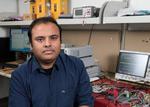Other

“A team of researchers from the Georgia Institute of Technology has developed a way to use 3-D printers to create objects capable of expanding dramatically that could someday be used in applications ranging from space missions to biomedical devices. The …

“A marimba-playing robot with four arms and eight sticks is writing and playing its own compositions in a lab at the Georgia Institute of Technology. The pieces are generated using artificial intelligence and deep learning. Researchers fed the robot nearly …

“Some problems are so challenging to solve that even the most advanced computers need weeks, not seconds, to process them. Now a team of researchers at Georgia Institute of Technology and University of Notre Dame has created a new computing …

“Ask Georgia Tech researchers working with advanced materials for examples, and they give a pop culture reference. Two of them even cite the same reference. “It’s like The Terminator, liquid metal that then becomes a solid,” says Alberto Fernandez-Nieves …

“By analyzing network traffic going to suspicious domains, security administrators could detect malware infections weeks or even months before they’re able to capture a sample of the invading malware, a new study suggests. The findings point toward the need …

“Georgia Institute of Technology researchers have created a team of free-flying robots that obeys the two rules of the air: don’t collide or undercut each other. They’ve also built autonomous blimps that recognize hand gestures and detect faces …

“This may sound like a familiar kind of riddle: How many brilliant mathematicians does it take to come up with and prove the Kelmans-Seymour Conjecture? But the answer is no joke, because arriving at it took mental toil that spanned …

“Using nanometer-scale components, researchers have demonstrated the first optical rectenna, a device that combines the functions of an antenna and a rectifier diode to convert light directly into DC current. Based on multiwall carbon nanotubes and tiny rectifiers fabricated onto …

“Based on multiwall carbon nanotubes and tiny rectifiers fabricated onto them, the optical rectennas could provide a new technology for photodetectors that would operate without the need for cooling, energy harvesters that would convert waste heat to electricity – and ultimately …
